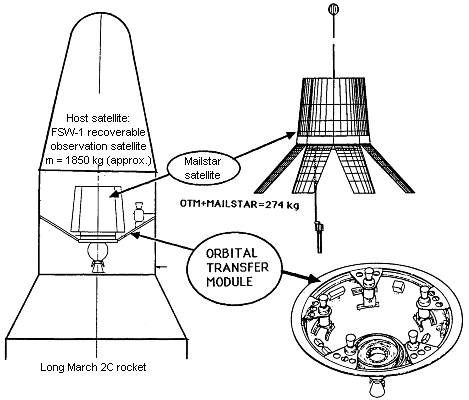 Background
Background Background
BackgroundIn 1987, when the definition study of Mailstar was in its final stages, it was felt that so-called VSATs (Very Small Aperture Terminals) could be more effective in serving the customers than the Mailstar concept. In effect, the project was canceled. However, the Swedish Space Corporation had signed the launch reservation agreement for launching Mailstar on CZ-2C and felt that the price for the launch was very attractive and could possibly be used for another project. Therefore contacts were taken with the scientists involved with the Swedish Viking satellite to see if a scientific satellite project could be defined that utilized this launch opportunity. During the autumn of 1987 such a project was outlined and the launching contract was signed with China Great Wall Industry Corporation on 19 November 1987.
Just as for the Mailstar
satellite, auxiliary propulsion would be needed to reach the operational
orbit from the very low orbit provided by the CZ-2C. The new satellite
concept, dubbed Freja, would need to a solid rocket motors to achieve an
orbit from which meaningful space plasma physics observations could be
made. During 1988 this project went through a definition study. In the
course of this study contacts with the Chinese were continued, both the
commercial partner the China Great Wall Industry Corporation and the rocket
manufacturer Beijing Wan
Yuan Industry Corporation (nowadays China Academy of Launch vehicle
Technology - CALT). As a part of these contacts we received an invitation
to witness the launch in August 1988 of a CZ-2C rocket carrying an FSW-1
observation satellite.
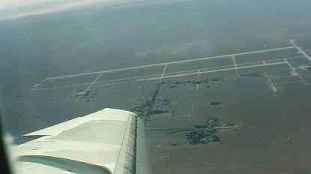 The
CZ-2C launch pad,
designated "Launch Pad 128" is located at 41.118 N, 100.316 E, 994.8 meters
above sea level. The airport (JSLC facility #14) is located at 40.25
N 99.48 E, 1145 meters above sea level. This is approximately
97 km south of the launch pad. A picture of the airport is shown on the
right. The camera is looking east, so north is on the left. There are some
trees and bushes that look like green patches. (Click
here
to see annotated US reconnaissance satellite CORONA picture of the airport
taken in 1972. Obtained from the web site of the Federation of American
Scientists, www.fas.org)
The
CZ-2C launch pad,
designated "Launch Pad 128" is located at 41.118 N, 100.316 E, 994.8 meters
above sea level. The airport (JSLC facility #14) is located at 40.25
N 99.48 E, 1145 meters above sea level. This is approximately
97 km south of the launch pad. A picture of the airport is shown on the
right. The camera is looking east, so north is on the left. There are some
trees and bushes that look like green patches. (Click
here
to see annotated US reconnaissance satellite CORONA picture of the airport
taken in 1972. Obtained from the web site of the Federation of American
Scientists, www.fas.org)
The airport is connected with the JSLC base area and the rest of China via a railroad. There is a train station adjacent to the airport. The area halfway between the tip of the wing of the plane and the right edge of the picture is the railway station. All our equipment was flown in by air and transferred to the train that takes about 90 minutes to reach the JSLC base area, also called "Dong Feng", the "East Wind". The train travels through desert and at one point passes near some rather large sand dunes. At that point there is a house with a detachment of soldiers that have as their duty to keep the track clear of sand. Once, during our stay in September 1992, there was a sand storm the day before we were sending a group of people back to Sweden and when the train reached the dunes, it had to stop to avoid being derailed and the soldiers cleared the track!
Dong Feng is about 31 km south of the launch pad. The Technical Center, where rockets and satellites are assembled is situated a bout 20 minutes car ride form the hotel. Each work site at JSLC is to some extent self-reliant. We were somewhat surprised to see that the staff who work at the technical center also live there and keep animals (pigs). The same is true for the launch pad. South of Dong Feng there is a large water reservoir that probably is replenished during the few rainy periods. The reservoir is also used for breeding fish and we actually went fishing there during our visit in June 1991.
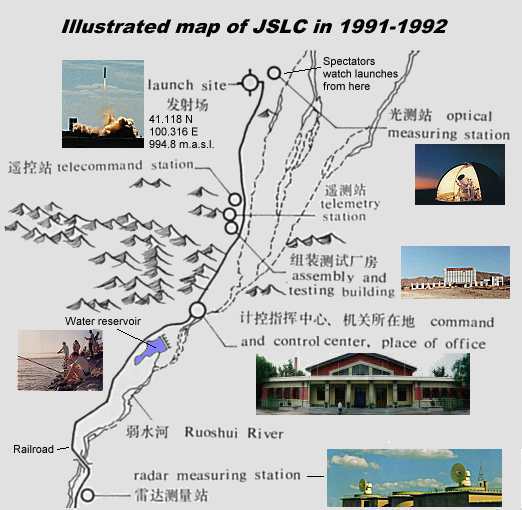
The Dong Feng Hotel,
in "downtown JSLC", "Home away from Home"
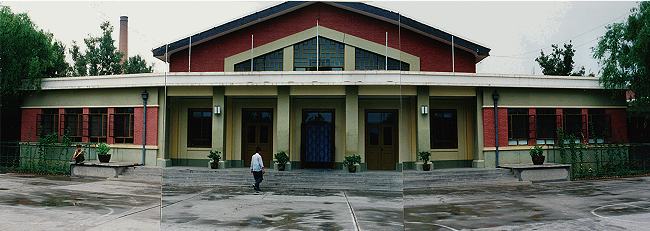
The main banquet hall is straight ahead. Our dining room was in the right wing which connected to the hotel room buildings. In 1992 we played land hockey outside the front door at night using our solar array test lamp as illumination. |
The rocket took off exactly on time at 1620 local time (0730 UT) and passed above and to the south of our observation point. Actually it felt as if the vehicle passed directly above us, but that was not entirely true. The FSW-1 satellite(1988-67A) entered an orbit at 63 degrees inclination at an altitude of 206-310 km. The recoverable capsule of the satellite came down after 8 days, around 0520 UT on 13 August 1988.
The next day (6 August) we
traveled to the Xian satellite Control center where the satellite was controlled.
The flight back to beijing with the Trident jet was very adventurous. A
severe rainstorm swept over Beijing and the pilot could not land at the
Wan Yuan airport. Instead he chose to land at the private airport of the
country's top leaders west of Forbidden City. It was the most terrifying
descent I have ever experienced. My guess is that the airport for the leadership
was chosen because it had adequate ILS facilities..... . We left China
for Sweden on 8 August 1988 definitely impressed by the smooth professionalism
of the launch crew at JSLC.
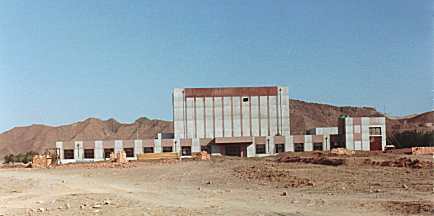
The "BM" building under construction in June 1991. The building had a low office part and a high-bay area where we assembled Freja. |
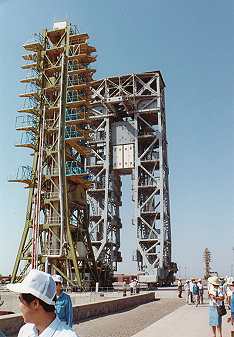
The Chinese side had also built cleanrooms in the service tower. The lower, white, cleanroom seen in the picture covered Freja. |
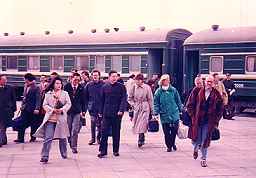
We arrive at the JSLC railway station after two hours' train ride from the airport (#14), I am in the front, on the right. |
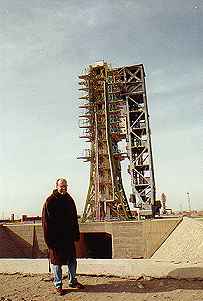
Myself in front of the flame pit of the CZ-2C launch pad and gantry. |
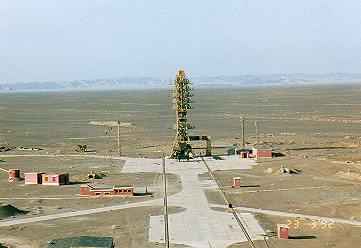
The CZ-1 launch pad from where the first Chinese satellite was launched in April 1970. A view from the gantry looking north-west. |
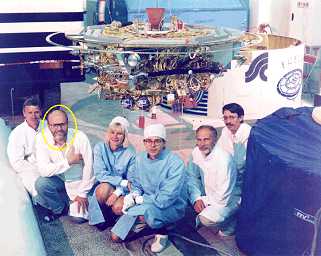
The last picture of Freja taken in the assembly hall on 25 September 1992. Myself in the yellow circle. Other team members: Left to right: Göran bergman, myself, Anna Laurin, Peter Rathsman, Bengt Holmqvist, Gudmund Johansson. |
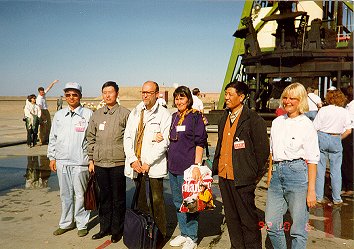
Gathering at the sooty, and still warm, launch pad about 25 minutes after lift-off. The lady with the plastic bag holding my arm is my wife, Inger Albrecktsson. The blockhouse can be seen behind my head. I stayed there at lift-off. The walls were shaking a bit, but not as much as I had expected! |
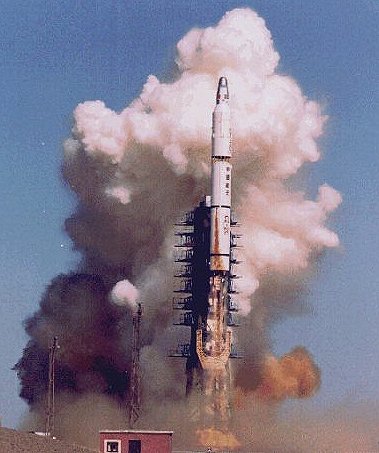
The Long March 2C rocket takes off frpm JSLC on 6 October 1992 at 0620 UT carrying the Chinese FSW-1 satellite and the Swedish Freja scientific satellite. |